The 2013 MacBook Air Review (13-inch)
by Anand Lal Shimpi on June 24, 2013 12:01 AM ESTThe GPU: Intel HD 5000 (Haswell GT3)
Hire enough ex-ATIers and you’ll end up really caring about GPU performance apparently. It’s good to see that Apple still views increasing GPU performance as non-negotiable, even at the MacBook Air level. Discrete GPUs are out of the question in the MacBook Air, so all models ship with Intel’s on-die processor graphics. More importantly, all CPU choices integrate the largest GPU offering: Intel’s HD 5000 (aka GT3).
Clock speeds alone prevent the 40 EU GPU implementation from being called an Iris 5100. Given the 15W TDP limit, Intel wouldn’t be able to do the Iris name justice even if it tried.
It’s hilarious that Intel refused to give out die photos for anything other than quad-core Haswell GT2, citing competitive concerns, yet at Apple’s WWDC launch of the new MacBook Airs we got to see the first die shot of a dual-core Haswell GT3. Update: I stand corrected. Intel posted its own shot here.
From the die photo it’s very obvious that like the quad-core Haswells with Iris Pro, the dual-core GT3 parts are over half GPU. Here's the only Haswell die shot Intel PR officially released by comparison, a quad-core GT2 part that's mostly made up of CPU cores:
Similar to the CPU discussion, on the GPU front Haswell has to operate under more serious thermal limits than with Ivy Bridge. Previously the GPU could take the lion’s share of a 17W TDP with 16 EUs, now it has 15W to share with the PCH as well as the CPU and 2.5x the number of EUs to boot. As both chips are built on the same 22nm (P1270) process, power either has to go up or clocks have to come down. Intel rationally chose the latter. What you get from all of this is a much larger GPU, that can deliver similar performance at much lower frequencies. Lower frequencies require lower voltage, which in turn has a dramatic impact on power consumption.
Take the power savings you get from all of this machine width, frequency and voltage tuning and you can actually end up with a GPU that uses less power than before, while still delivering incrementally higher performance. It’s a pretty neat idea. Lower cost GPUs tend to be smaller, but here Intel is trading off die area for power - building a larger GPU so it can be lower power, instead of just being higher performance.
| A Historical Look at MacBook Air GPU Performance | |||||||||
| 2011 | 2012 | 2013 | |||||||
| GPU | Intel HD 3000 | Intel HD 4000 | Intel HD 5000 | ||||||
| Manufacturing Process | 32nm | 22nm | 22nm | ||||||
| Frequency | 350/1150MHz | 350/1050MHz | 200/1000MHz | ||||||
| Cores | 12 | 16 | 40 | ||||||
| Peak GFLOPS | 165.6 GFLOPS | 268.8 GFLOPS | 640 GFLOPS | ||||||
| TDP | 17W | 17W | 15W | ||||||
This is an even bigger deal because few of the other OEMs seem interested in paying for the larger die. Acer’s S7 uses Intel’s HD 4400 (Haswell GT2, 20 EUs), as do most of the other Haswell Ultrabooks that have been announced thus far. Armed with a 2011, 2012 and 2013 MacBook Air as well as Acer’s 2nd generation S7, we now have the ability to compare everything from Intel’s HD 3000 (Sandy Bridge) all the way up to HD 5000. It’s important to keep in mind that with the exception of HD 3000, everything here is built on the same 22nm process, and with HD 4400/5000 TDPs actually went down. In other words, post Ivy Bridge, any GPU performance gains were very hard to come by.
I’m splitting up the GPU performance data into three sections. The first is a look at some games/settings that are actually playable on processor graphics. The second is comparison data for laptop Bench. The deltas here are academic at best since nothing slower than Iris Pro can really deliver playable frame rates in our high-end notebook GPU tests. The final section focuses on synthetic performance, which should help characterize the peak theoretical gains you can expect from HD 5000.
All of the gaming tests were run under Boot Camp/Windows 8. I think it’s time to retire the HL2/Portal testing under OS X.
Playable Gaming Performance
There's a surprising number of games that are actually playable on Intel's HD 5000 in the MacBook Air. You have to be ok with the fan spinning quite loudly, but it's possible to get some ultra portable gaming in if you're up for it.
For all of these tests I stuck with 1366 x 768 so I could run comparable data on the only HD 3000 equipped MBA I had, an 11-inch model. I also threw in data from Inte's HD 4400 using the new Haswell equipped Acer S7. I'll start with GRID 2, a brand new racer, running at relatively low quality settings.
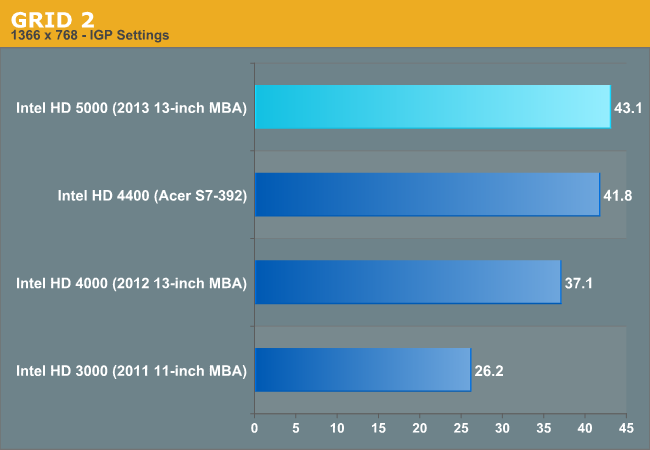
GRID 2 is absolutely playable on the new MacBook Air. At 43.1 fps it's 16% faster than last year's HD 4000 model. A 16% gain without increasing TDP on the same manufacturing process is pretty impressive. The gains over the 2011 MBA are substantial. GRID 2 goes from almost playable to fast enough where you can actually turn up some of the quality settings if you wanted to.
Next up is Borderlands 2. Again, a fairly modern title, but one that's really optimized for current generation consoles - making high-end processor graphics more than up for the task. While a higher TDP implementation of Haswell's integrated graphics wouldn't have an issue here, things are a little more difficult with a 15W TDP.
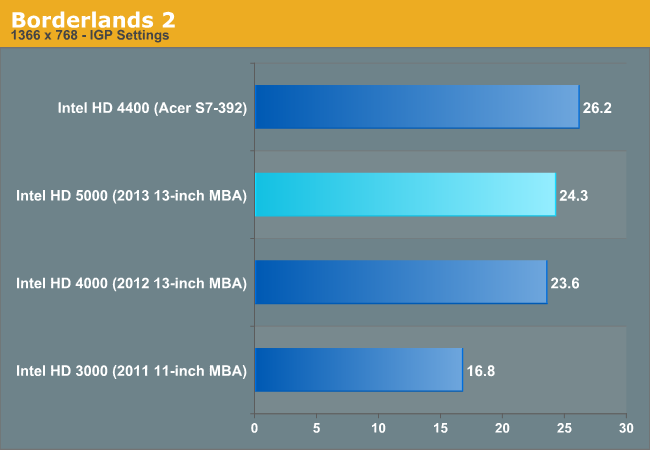
We see a marginal improvement over the HD 4000, we're clearly thermally bound at this point. What's interesting is the HD 4400 on the S7 is actually quicker here. The difference could be cooling or how Apple decides to scale back on GPU frequency when faced with thermal limits. A quick look at Haswell's power reporting confirms that while running my Borderlands 2 test the GPU was already exceeding the PL1 (Power Limit 1) of 15W:

Remember, with Sandy Bridge Intel introduced Turbo Boost 2.0 that effectively allowed for two separate power limits - one equal to the processor's TDP (PL1) and one higher than the processor's TDP (PL2) that could be hit as long as the die temperature doesn't get too high.
Despite the sub 30fps frame rate in this benchmark, Borderlands 2 was definitely playable on the HD 5000. It wasn't always smooth but if you need your single player fix, it'll suffice.
I've had a few requests to bring back our Minecraft benchmark. We ditched it from our higher end GPU reviews since it's no longer stressful enough, but for 15W TDP iGPUs it's perfect.
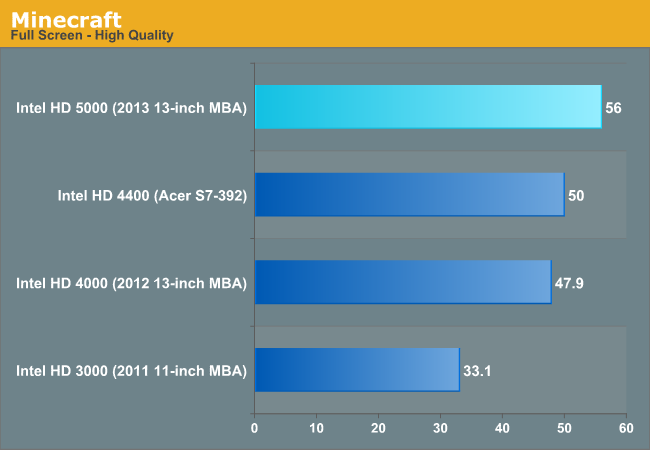
Once again we see almost a 17% increase over Intel's HD 4000. The HD 4400 comparison is also very impressive with a 12% increase in performance vs. what most MBA competitors will be using.
When I was a kid all I wanted was a console that could play arcade quality ports of Street Fighter II and Mortal Kombat II. These days, even the latest Street Fighter title has no issue playing on free graphics:
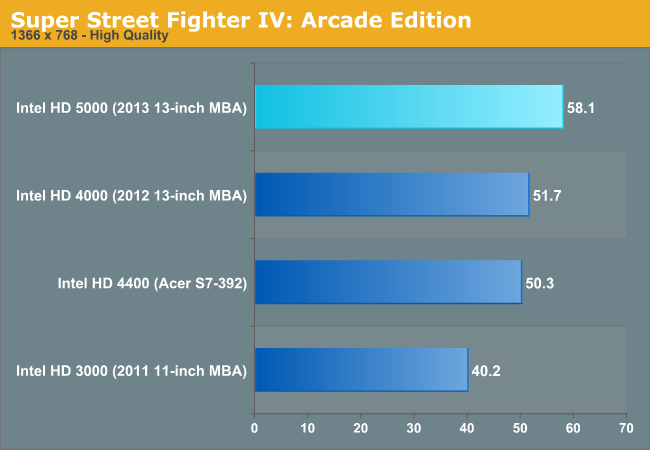
16% seems to be the magic number as that's exactly how much faster HD 5000 is compared to HD 4000. Given the lower TDP this year, that's a pretty reasonable gain. Looking at the sheer number of transistors that had to be used to get there however gives you good insight into just how hard it is to improve performance without a corresponding process node shrink.



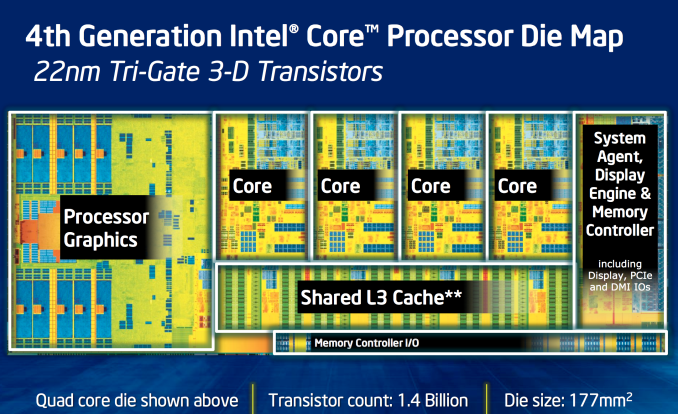
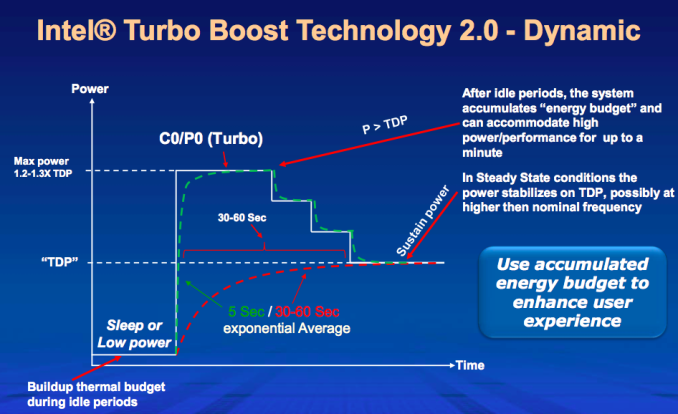








233 Comments
View All Comments
appliance5000 - Friday, December 20, 2013 - link
One word - tablets.mikeztm - Monday, June 24, 2013 - link
Could that PCIe ssd works with Filevault2 without performance down?My 2011 MBA's SSD became much slower after enabling Filevault2.
|-8-| - Monday, June 24, 2013 - link
>Five years after its introduction, the MacBook Air really has>grown into a very polished, mature platform. The 2013
>model is really the epitome of what Apple set out to
>build back in 2008, we just finally have the right hardware
>available to realize the vision. Nearly every component has
>been perfectly selected.
For a ultramobile working horse, there are still some substantial shortcomings: It's still a glossy display tying your work place to indoor use or cloudy weather. There is still no LAN, no VGA - this makes many headaches in business everyday life.
Maybe the author better leaves the marketing to Apple and concentrates on listing the Pros AND Cons of the product. It's a fine notebook, but definitely not perfect. ;)
weiran - Monday, June 24, 2013 - link
You forget not everyone works in a corporation and has your requirements, especially considering this is a consumer device first and foremost. Apple looks to the future, which may mean minor pain in the short-term (having to use adapters for LAN and VGA), but realistically do you think in 2-3 years either of those will exist on any consumer laptop?|-8-| - Monday, June 24, 2013 - link
It's not about having these or that requirements. The author is praising something to the skies, that has obvious short comings. (Every product has that.) What would be more 'neutral' verbalised: The components are perfectly selected. [...]. There are a few compromises, so the screen has good contrast, but isn't really usable outside, for example in a park. Further missing legacy ports force to carry adapters for using old legacy infrastructure like LAN networks or common LCD projectors.It's about writing a review - I don't want to read someones marketing arguments.
And by the way: Yes, VGA and LAN will be important in the future - most LCD projectors still have VGA and in contrast to HDMI or Displayport it really works reliable. I was at a conference a month ago - VGA saved me as Displayport wasn't working at all.
LAN is without alternative to share and synchronise big amounts of data.
Grennum - Monday, June 24, 2013 - link
VGA is certainly dying. By the end of the year all of the projects in our boardrooms will be replaced with Smart Screens, which you connect to via Wi-Fi. We have wired HDMI as a back-up works perfectly.Wired LAN is not dying by why would you ever have large amounts of data on your ultra portable laptop? That is just be irresponsible. If you are working with large data sets best to do it on a remote system where you have the performance, and reliability.
This laptop would perfectly meet the needs for many of our business users, maybe not engineering, but then engineering wouldn't be looking at an ultraportable (remote engineering desktops notwithstanding)
|-8-| - Monday, June 24, 2013 - link
Maybe I should switch to your company. ;) There are some new projectors here having HDMI (sadly no Displayport). But most projectors are quite old (still working), these are connected via VGA. There is some time left, till the last old projectors die.Honestly I don't see a bonus in digital alternatives. THE standard is still missing, as most notebooks have either HDMI or Displayport.
WLAN seems to have high signal latency between two computers. If you syncronise two big collections of many many subfolders and many small files in there, you notice a huge difference even between 100 MBit/s LAN and 300 MBit/s WLAN. I use WLAN for backups, but speed sucks.
Another problem is security of data in the private sector, these security guys don't like WLAN.
A5 - Monday, June 24, 2013 - link
Then maybe don't work in a park? I don't know of any laptop with a bright enough screen and good enough battery life to actually work outdoors.|-8-| - Monday, June 24, 2013 - link
Well, the Samsung Series 9 900X3C-A04DE or the Lenovo x220/x230 are two, that can be used outdoors. There should be more, some Zenbooks have also matte screens.darwinosx - Monday, June 24, 2013 - link
Well Samsung makes cheap junk that doesn't work and has no support.